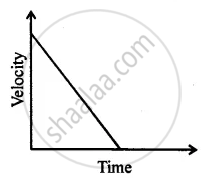Advertisements
Advertisements
प्रश्न
Write three equations of uniformly accelerated motion relating the initial velocity (u), final velocity (v), time (t), acceleration (a) and displacement (S).
उत्तर
Three equations of a uniformly accelerated motion are
v = u + at
s = ut + (1/2)at2
v2 = u2 + 2as
APPEARS IN
संबंधित प्रश्न
Explain why, the motion of a body which is moving with constant speed in a circular path is said to be accelerated.
A bus running at a speed of 18 km/h is stopped in 2.5 seconds by applying brakes. Calculate the retardation produced.
Derive the formula : v = u + at, where the symbols have usual meanings.
Derive the formula s= `ut+1/2at^2` , where the symbols have usual meanings.
A freely falling object travels 4.9 m in 1st second, 14.7 m in 2 nd second, 24.5 m in 3rd second, and so on. This data shows that the motion of a freely falling object is a case of :
The slope of a speed-time graph gives:
State how the velocity-time graph can be used to find
The acceleration of a body
Multiple choice Question. Select the correct option.
The speed of a car reduces from 15 m/s to 5 m/s over a displacement of 10 m. The uniform acceleration of the car is :
Can you suggest a real-life example about the motion of a body from the following velocity – time graph?

An electron moving with a velocity of 5 × 104 ms−1 enters into a uniform electric field and acquires a uniform acceleration of 104 ms–2 in the direction of its initial motion.
(i) Calculate the time in which the electron would acquire a velocity double of its initial velocity.
(ii) How much distance the electron would cover at this time?
